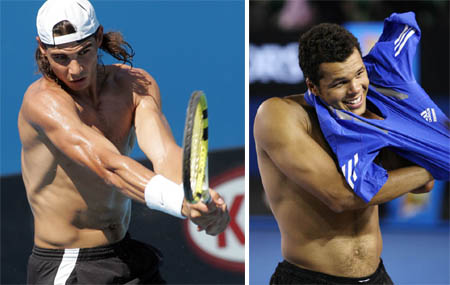DavaiMarat
Professional
Hi guys,
I've taken a recent interest in the 2handed backhand. I'm a 5.0 former college player but for instructions sake I started to break down all the 2HBH instruction I found in books, video and web. It's a very complicated shot actually with a myriad of grip combinations, right and left arm dominant styles so I found it a interesting case study.
One of the common trend I see is the how most instructors try to make the 2HBH a one handed lefty forehand. I feel this is a bit of a misnomer. In a properly leveraged forehand should incorporate a double bend structure to allow the mass of the body to move into the shot. However, it's more commonly accepted to keep the left arm straight throughout the show until the top of the follow through.
Now what's more interesting is the fact that some women and smaller players use a bent arm in their 2HBH. This oddly resembles the a modern left handed (dbl bend) closer then the straight arm example that a lot of instructors tote. It's seems to provide more body leverage yet requires more torque from the larger muscles in the waist, legs and hip. Is this because smaller players lack natural arm strength?
More confusion arrises from the follow through position. Most 2HBH end up following thru above the shoulder yet with the common day forehand (windshield wiper style), the follow through end up mid chest or even down ay the waist.
I understand why instructors are trying to convey. The left arm drives the 2HBH. However this isn't necessarily the case. Only in the some grip combinations this is true (Eastern/Eastern or Eastern/Continental) but there are grips that act more like a 1handed backhand where the left arm is stabilizing/guiding.
So I guess I'll start with the questions.
What are the advantages of the bent arm 2handed backhand versus the straight arm?
Is calling the 2HBH a lefty Forehand really a misnomer?
Who wants to debate biomechanics? Will, Buffalo, Tricky?
I'm interested in your views.
I've taken a recent interest in the 2handed backhand. I'm a 5.0 former college player but for instructions sake I started to break down all the 2HBH instruction I found in books, video and web. It's a very complicated shot actually with a myriad of grip combinations, right and left arm dominant styles so I found it a interesting case study.
One of the common trend I see is the how most instructors try to make the 2HBH a one handed lefty forehand. I feel this is a bit of a misnomer. In a properly leveraged forehand should incorporate a double bend structure to allow the mass of the body to move into the shot. However, it's more commonly accepted to keep the left arm straight throughout the show until the top of the follow through.
Now what's more interesting is the fact that some women and smaller players use a bent arm in their 2HBH. This oddly resembles the a modern left handed (dbl bend) closer then the straight arm example that a lot of instructors tote. It's seems to provide more body leverage yet requires more torque from the larger muscles in the waist, legs and hip. Is this because smaller players lack natural arm strength?
More confusion arrises from the follow through position. Most 2HBH end up following thru above the shoulder yet with the common day forehand (windshield wiper style), the follow through end up mid chest or even down ay the waist.
I understand why instructors are trying to convey. The left arm drives the 2HBH. However this isn't necessarily the case. Only in the some grip combinations this is true (Eastern/Eastern or Eastern/Continental) but there are grips that act more like a 1handed backhand where the left arm is stabilizing/guiding.
So I guess I'll start with the questions.
What are the advantages of the bent arm 2handed backhand versus the straight arm?
Is calling the 2HBH a lefty Forehand really a misnomer?
Who wants to debate biomechanics? Will, Buffalo, Tricky?
I'm interested in your views.








